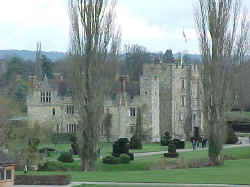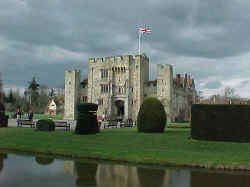Hever, Kent
Rectory at Hever
In consequence of the act passed in 1515 for the
surrender of all religious houses with less than £200 of
clear yearly revenue, the advowson of the rectory of Hever
came to the Crown (Henry VIII) in that year. Soon
afterwards, this advowson was granted, along with the site
of the priory, to Thomas Culpeper10b of
Bedgebury. He didn't hold it long, and it appears by the Escheat
Rolls to have come again into the hands of the crown, and
was granted by the king in 1542 to Sir John
Gage, to hold in capite by knights service. Sir John
exchanged it again with Thomas Culpeper (evidenced by an act
passed the year after). His son and heir, Sir Alexander Culpeper11b
of Bedgebury, had possession granted of sundry premises,
among which was the advowson of Hever, held in capite
by knights service in 1555-6. The year after it was, among
other premises, granted to Sir Edward Waldegrave to hold by
the like tenure. (Hasted Volume III, pages 200-201). |
 St.
Peter's Church, Hever St.
Peter's Church, Hever
Ancient Parish.
Original registers
from 1632.
Location: On Hever Road, in the
middle of Hever
National Grid Coordinates: TQ
476 448
In the north chancel there is a magnificent
tomb of Sir Thomas Boleyn, Earl of Wiltshire and
father of Queen Ann Boleyn.
In the belfrey there is a stone with a brass
plate and French inscription for John Cobham, Esq., (died
1399) and Joan Lewknor, his wife. The same arms are
displayed for John as were used by the Sterborough Castle
branch of the Cobhams. Alianora (Eleanor) Culpeper, daughter
of Sir Thomas Culpepper6bh of Bayhall,
Hardreshull and Exton, married Sir Reginald Cobham of
Sterborough Castle.
There is no evidence of any Culpeper presence at this church. |
Hever, Kent
Location: 20 miles
WSW of Maidstone and 17 miles WNW of Goudhurst
National Grid Coordinates:
Village: TQ
476 448
Castle: TQ
478 452
 The tiny village of Hever, near
Edenbridge, is set in delightfully unspoiled countryside, with
orchards and woodlands surrounding it. Most visitors, impressed
as they may be with this tidy settlement, make for the star
attraction here, and the reason why Hever figures prominently on
anyone's checklist of things to see in Kent. The tiny village of Hever, near
Edenbridge, is set in delightfully unspoiled countryside, with
orchards and woodlands surrounding it. Most visitors, impressed
as they may be with this tidy settlement, make for the star
attraction here, and the reason why Hever figures prominently on
anyone's checklist of things to see in Kent.
The village is the site of Hever
Castle, which is redolent of history and more than a little
tragedy. The castle achieved its present form in 1272 when Sir
Stephen de Penchester received permission from Edward I to
convert his house at Hever into a castle. The massive Gatehouse,
the outer walls and the moat strengthened its position as a
fortification.
 Two
centuries later the Boleyn family bought the castle and rebuilt
much of it, adding a comfortable Tudor residence inside the
walls. It was here that the ill-fated Anne Boleyn, mother of
Elizabeth I, was courted by Henry VIII. The castle still
contains many mementoes of her. In 1903 Hever Castle was bought
by American millionaire William Waldorf Astor, who restored the
original buildings and set about building the "Tudor
Village", gardens and lake. All of these can be visited, as
well as Hever Castle itself, with its fine collections of
paintings, furniture and varied objets d'art. Hever Castle,
Hever, near Edenbridge, Kent TN8 7NG, Tel: 01732 865225 Two
centuries later the Boleyn family bought the castle and rebuilt
much of it, adding a comfortable Tudor residence inside the
walls. It was here that the ill-fated Anne Boleyn, mother of
Elizabeth I, was courted by Henry VIII. The castle still
contains many mementoes of her. In 1903 Hever Castle was bought
by American millionaire William Waldorf Astor, who restored the
original buildings and set about building the "Tudor
Village", gardens and lake. All of these can be visited, as
well as Hever Castle itself, with its fine collections of
paintings, furniture and varied objets d'art. Hever Castle,
Hever, near Edenbridge, Kent TN8 7NG, Tel: 01732 865225
Source: Sean Connolly, Ed., The Hidden
Places of Kent, Travel Publishing, Ltd., 1998., pages 71-72.
Photographs taken by Warren Culpepper, March
2000. Postscript by Warren Culpepper: I
found Hever Castle to be quite interesting and well worth a
visit. However, I could find no evidence of a Culpeper presence
at the castle. |
1831 Topographical
Dictionary of England
HEVER, a parish in the
hundred of SOMERDEN, lathe of SUTTON at HONE, county of
KENT, 8½ miles SW from Tunbridge, containing 606
inhabitants. The church, dedicated to St. Peter, contains
a magnificent monument of the Boleyn family.
The castle,
the seat of that illustrious house, is a very ancient
building, defended by a moat, drawbridge, portcullis, and
tower. It was the residence of Sir Thomas Boleyn, father
of Ann Boleyn, queen of Henry VIII, who is stated to have
been born here, and here Anne of Cleves died. The chamber of
Ann Boleyn is still called by her name, and several other
curious mementos are shown to visitors. |
Hever Castle's "Haunted House Story"
The ghost of Anne Boleyn is said to return to her old home at Hever Castle,
where every Christmas Eve she is seen to walk over the bridge which crosses
the River Eden in the castle grounds.
The great oak, under which Henry VIII courted Anne, still stands. Her
ghost has been seen there as well, usually at Christmas time.
Another ghost at Hever is that of a local farmer, called Humphrey, who
was robbed and killed there.
Source: Ghosts
of the Southeast, a web site describing haunted
houses in Southeastern England. |
Last Revised: 02 Jan 2015
|
|